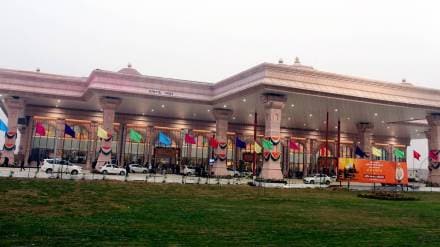The transformation of the compact 178-acre airstrip into the expansive 821-acre Maharshi Valmiki International Airport in Ayodhya is hailed as a testament to the efficiency of the double-engine government, as stated by the Uttar Pradesh government. Achieved within two years, the Yogi government, with an additional expenditure of Rs 1175.97 crore, showcased the collaborative efforts between the central and state governments. The chief architect of the Ayodhya airport, Harsh Varshney, Principal Architect and Director of STHAPATI, said “over the past decade, India has witnessed remarkable growth in aviation traffic and infrastructure, with the Ayodhya Airport standing out as the latest milestone in this transformative journey. The airport not only serves as an infrastructural marvel but also signifies a commitment to comprehensive community development and cultural enrichment.”
Here are the top 5 facts which details on the two year journey Maharshi Valmiki International Airport:
Major challenges
Initiated on December 2, 2021, the Ayodhya International Airport faced challenges, with land acquisition being a major hurdle. Notably, the Yogi government acquired 500 acres of private land without disputes, setting a significant example. Of the total project area, 182 acres were already registered, while 139 acres were acquired from various state government departments and institutions. Dikshu Kukreja, renowned Architect, Managing Principal CP Kukreja Architects and Master planner for Ayodhya City said, “since the last couple of years and after the announcement of Ram Mandir Project there has been a lot of speculative of land in and around the city of Ayodhya and Faizabad. There have been many land deals around the airport with this whole idea in mind of natural phenomena of the expansion of the airport in the future.”
How the challenges being overcame
Overcoming challenges like relocating power lines, removing university buildings, and shifting infrastructure, the government efficiently completed tasks such as runway expansion, taxi track construction, and terminal building development. The timely completion of lighting, fire station, stormwater drainage, and other facilities highlights the effective handling by the double-engine government.
On December 30, first phase of Ayodhya Airport opened
The airport, a crucial component in Ayodhya’s progress, has completed its first phase, featuring a 65,000-square-foot terminal with a capacity for 2 to 3 flights per hour. The 2200-meter runway accommodates small and larger aircraft. The second phase aims to extend the runway to 3700 meters, enabling the landing of international aircraft like Boeing 787 and Boeing 777, along with a 5 lakh square feet terminal.
Enhance connectivity
In anticipation of a surge in tourism, the Ayodhya Airport’s passenger terminal is designed to accommodate 150 arrivals and departures simultaneously. The airport is poised to go beyond the ordinary, reflecting the cultural richness of Ayodhya and redefining contemporary airports to truly embody the city’s identity – becoming a symbol of pride for the aviation industry. For the devotees and pilgrims traversing the corridors of Ayodhya Airport, the journey holds both physical and spiritual significance. The airport’s strategic design aims to further establish Ayodhya as one of the world’s largest pilgrimage centers, offering seamless connectivity and enhancing the accessibility and enrichment of the pilgrimage journey to Ayodhya. “The city is witnessing a significant surge in annual pilgrim influx, with an expected tenfold increase by 2047, projecting an incredible ‘Citizens to Tourists Proportion’ of 1:10. This remarkable growth underscores Ayodhya’s pivotal role in spiritual tourism,” Kukreja added.
Ayodhya to become a modern hub
Ayodhya, the city of Lord Ram, is on the path to becoming a modern hub and the Maharshi Valmiki International Airport is instrumental in connecting Ayodhya to the nation and the world, contributing to the restoration of its lost glory.
